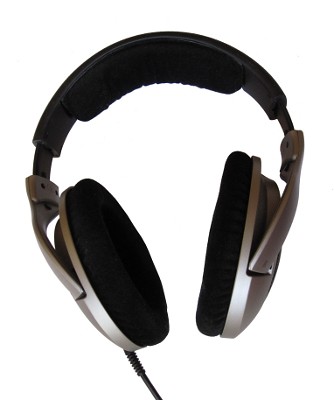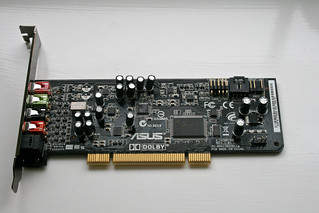 |
| Sennheiser HD555 Headphones by gcg2009, on Flickr |
Throughout my illustrious career as a PC gamer I've gone through countless headsets. For a while I would pick up a $10-15 Walmart special and use it for a year or so, usually up until the mic or one side of the headphones would die. I quickly learned how to twist the cord into just the right place to fix a loose connection and patch things up with electrical tape to keep my budget masterpiece going. Eventually I'd give up and trash the thing, find another cheap headset for less than 20 bucks and begin the cycle anew.
At some point I got fed up and thought, "maybe if I actually put some money into these I'll get better sound/mic quality and a better product that lasts for more than 12 months." I found a USB "gaming" headset, an AudioFX Pro 5+1 by Ben Heck, and paid about $65 for it. It was bulkier than the cheap behind-the-head headsets I had been buying, had some interesting styling, flashing lights on the earpieces that indicated listening volume, and best of all (or so I thought), it had a USB connection. This headset died on me after about 9 months and left me a bitter and angry individual. I begrudgingly went back to my $20 headset ways.
Last year, I decided to switch things up a bit. My Logitech G330 was being held together by tape after yet another 12-18 month performance - it was a decent headset that I had bought on sale, and Logitech is usually pretty good for peripherals on the cheap. Rather than checking Newegg or Amazon for my next victim, I decided to do some research and find a solid budget setup that would hopefully last me for a while.
Onboard Sound vs. Dedicated Sound Card
While onboard sound has come a long way in the last 5 or 10 years, you're essentially getting a cheap throw-in that motherboard manufacturers can use to say they're putting out a complete product. If you're on an extremely limited budget and would rather put more money towards a comfortable set of headphones it's not exactly the end of the world. With that being said, if you put some money into a decent sound card you'll be able to use your headphones to their full potential. If you put garbage in you'll get garbage out regardless of how much you spent on headphones, so a sound card isn't to be overlooked. There's a pretty good thread over on Overclock.net that discusses the differences in sound between onboard and discrete cards.
 |
| Asus Xonar DG Soundcard by William Hook, on Flickr |
Ditch the Headset and Grab a Desktop or Clip Mic
Most "gaming" headsets are pretty terrible in quality, unfortunately. The $35 pair of headphones I'm using now are a gigantic step up from the $65 USB "5.1" gaming headset I had used a couple of years prior. You're basically getting a half-decent set of headphones with a cheap mic attached to them at a price premium because of the gamer branding - think about all of the overpriced Fatal1ty crap that's out there. After using a headset with attached mic for almost 10 years I didn't think I'd be able to adjust to having a desktop mic, but it's really not too bad; I don't need to worry about flipping the mic out of the way when I'm eating or drinking something, and since the mic is sitting stationary on my desk I don't need to worry about the thing dying on me 5 months from now from regular use. You can also go with a clip mic that either attaches to your shirt or the headphone cable, but I decided not to go that route.
Choosing the Right Setup
So we've established that you should probably pick up a decent sound card and go with a pair of headphones with separate mic. I found a couple of invaluable resources when picking out my latest round of audio gear that helped point me in the right direction.
- Overclock.net's Computer Audio section - OCN is a forum with a large user base of computer enthusiasts. There are a ton of useful threads here in the audio section.
- Essential Reading for Audio Fans
- Ricsim's Guide to Computer Audio
- Guide to Gaming Headphones
- OCN's Most Recommended Audio Products
- HeadFi.org - These guys are some serious audiophiles. This site can be a little intimidating if you're just looking for a $50-100 set of headphones; it's kinda like asking a wine connoisseur what $30 bottle of wine you should buy at the liquor store. If you can pick up some of the terminology there's a ton of solid information here.
To summarize, if you want to get serious about your audio setup there are a number of things you'll need to consider. First, nail down your budget and decide whether or not there's enough room in said budget to pick up a sound card. Different headphones produce different types of sound, so you'll need to consider what types of games you play and what type of music you listen to - obviously someone who listens to Classical isn't going to pick up the same set of cans as someone who prefers Dubstep. When you're shopping for headphones themselves, avoid things like USB, "5.1 surround," and GAMERFRAGELITE FATAL1TY EDITION - USB bypasses the sound card you just bought, surround headsets give you a bunch of tiny little sound drivers in one spot that muddle the sound, and gaming headsets are usually of pretty terrible quality and almost always overpriced. Stay away from Beats Audio while you're at it, too. Now that I think about it, I'm surprised there isn't a Razer FATAL1TY Beats By Dre gaming headset for $400 available somewhere.
I picked up my sound card, an ASUS Xonar DG, through a Newegg Open Box listing for 12 bucks - don't think that a strict budget leaves you stuck with onboard sound, especially since that card is currently $15 after rebate. Don't forget to grab a mic with your headphones if you're on Ventrilo/Mumble/Skype all of the time. I picked up one of these bad boyson the cheap and everyone tells me I sound fine. I've also seen the Zalman Zm-Mic1
and Olympus ME-52W
recommended in the past.
I've been using my current setup for well over a year now and everything is still going strong - something I don't think I've ever been able to say in the past. Check out OCN and HeadFi, and happy shopping!











0 comments:
Post a Comment